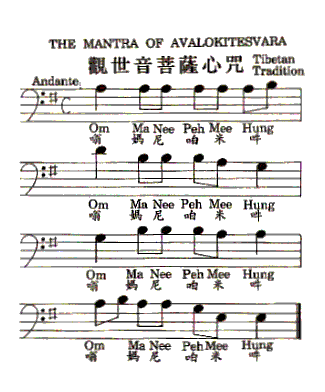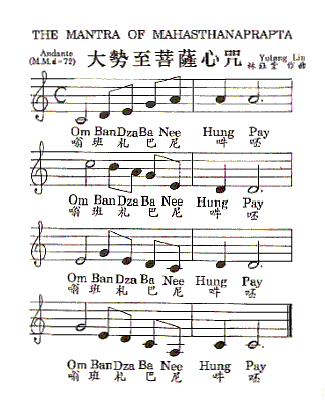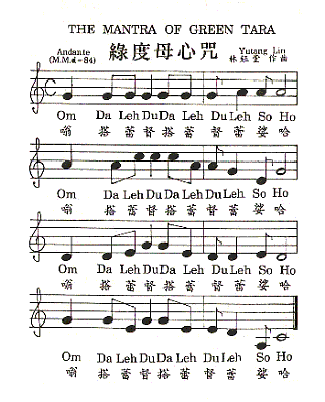Pureland Melodies
Written in Chinese by Yutang Lin
Translated by Chun Jane Chen
Table of Contents |
| Preface |
| 1. A Visualization for Singing the Mantra of Amitabha |
2. The Mantra of Amitabha Buddha: Weng A Mi Da Wa Xie |
| 3. Amitabha: A Mi Ta Ba |
| 4. The Mantra of Avalokitesvara: Weng Ma Ni Bei Mi Hong |
| 5. The Mantra of Mahasthanaprapta: Weng Ban Zha Ba Ni Hong Pei |
| 6. The Mantra of Green Tara: Weng Da Lei Du Da Lei Du Lei Suo Ha |
| Appendix Unification of Mind and Wind: A Wonderful Method of Chanting Amitabha |
Preface
Chanting of Buddha’s name when made into songs will be sung from the depth of people’s hearts, and hence, will move others’ spirits. Not only can it purify the singer’s mind, but it can also harmonize the whole society; thus, it is of great merit. That is why the ancient sages passed down the five-variation chanting of “Amitabha.” In the Tibetan tradition there is also the popular melody of singing the Mantra of Avalokitesvara. I have given a brief introduction to the five-variation chanting of “Amitabha” in booklet No. 4 of the Chenian Memorial Series (note: Chapter 4 of this book). In this booklet we have provided a music score for the beautiful Tibetan singing of the Mantra of Avalokitesvara.
Members of the Miami Buddhist Association tried to compose a song for the Mantra of Mahasthanaprapta, so that each of the Three Holinesses of the Western Pureland would have a mantra song to be propagated. When I heard about this, I spontaneously sang out a melody for this mantra; however, I did not know anything about composing, and I got only three phrases with an ambiguous rhythm. Fortunately, Mr. Kuan-Shu Song of Miami kindly pointed out the problems to me, so I completed the song with four phrases. This is how I obtained the mantra song contained in this booklet.
A popular Chinese chanting of the Holy Name of Amitabha with four notes for the four syllables is simple, stable, and helpful for the practice. Therefore, I have included it in this booklet. Upasaka Song-Yi Tang of Tao-yuan, Taiwan, who has released more than one million lives over the past twenty years, mentioned in one of his letters to me that he had a tape of this chanting; and every time after playing it, even though the tape had been taken out of the machine, he could still hear the song for ten minutes. He had tested it repeatedly and this miraculous result occurred without fail.
After the songs for the mantras of Avalokitesvara and Mahasthanaprapta became available, it would be regretful if the mantra of Amitabha was left out. Therefore, at first I designed a visualization for chanting this mantra, visualizing the Dharmakaya light of the whole Dharmadhatu going up and down through the Central Channel to help open it up. Then I composed the song.
The mantra of Green Tara, who is a transformation of Avalokitesvara, is also very popular. After one sitting meditation I composed the melody for this mantra. The first phrase was an extension of the first phrase of the melody of Avalokitesvara’s mantra, and the remaining three phrases just came out naturally. In one minute I finished composing the whole song.
All the music scores contained in this booklet were arranged by Upasika Chun Jane Chen. All the songs included in this booklet are related to the Holinesses of Pureland; hence, it is entitled “Pureland Melodies.” Our aim is to help people’s practice; therefore, the melodies are all very simple. Those pieces that I composed came out naturally from my heart. Although they are not academic works, may be they will produce echoes in other practitioners’ hearts.
I hope that this offering of my elementary work will stimulate some Buddhist musicians to compose more beautiful melodies for mantras.
July 2, 1990
This morning the number of Dragon Vases that we have offered went up to 300.
A Visualization for Singing the Mantra of Amitabha
The compassionate vows of Amitabha Buddha encompass all sentient beings in the Dharmadhatu; he helps them reach the “Utmost Joy Pureland,” i.e., returning to the original pure nature of the Dharmadhatu, by operating his limitless Buddha power.
This visualization for singing his mantra is based on the above understanding.
Before singing the mantra visualize the following: the whole Dharmadhatu is a boundless blue space; below are the sentient beings, transparent yet intangible like a rainbow; the blue sky above represents the Dharmakaya of Amitabha Buddha (in fact, the whole Dharmadhatu is his Dharmakaya, not just the upper part); you appear as a Nirmanakaya of Amitabha Buddha, hollow as a bubble and transparent like a rainbow; your Central Channel is as thin as your pinkie finger, and it is red outside and white inside.
While singing the mantra, visualize as follows:
The first phrase:
Om—All sentient beings below are transforming into sky-blue light.
Ah Mee Da Wa—The blue light enters from below into your Central Channel and ascends to the top.
Sheh—The blue light goes out from the top of the Central Channel and merges into the Dharmakaya light.
The second phrase:
Same as the first phrase, but the light becomes brighter.
The third phrase:
Om—The Great Compassion and the Great Power of Amitabha Buddha above are manifesting as sky-blue light.
Ah Mee Da Wa—The blue light enters into your Central Channel from above and descends to the Bottom.
Sheh—The blue light goes out from the bottom of your Central Channel and shines upon all sentient beings, thereby, making them appear more brilliant than before.
The fourth phrase:
Same as the third phrase, but the light becomes brighter.
In this visualization, the Great Compassion (Buddha’s compassionate vows of saving all sentient beings), the Great Power (Buddha’s limitless merits for purifying sentient beings’ karmas), and the Great Wisdom (of returning to the original pure nature of Dharmadhatu) are unified. The “going up and down” of the Dharmakaya light would make the practitioner’s body cool, comfortable and tranquil; besides, it would help open up the Central Channel. This practice utilizes the view of the whole Dharmadhatu to help develop the Central Channel.
This practice consists of singing the mantra and doing the visualization simultaneously, but you don’t need to sing it out loud. During the practice, if you go into a deep meditative state, you can stop the singing, and even the visualizing. Just let the Dharmadhatu appear and stay by itself.
June 21, 1990
The Mantra of Amitabha Buddha: Weng A Mi Da Wa Xie

Amitabha: A Mi Ta Ba

The Mantra of Avalokitesvara: Weng Ma Ni Bei Mi Hong

The Mantra of Mahasthanaprapta:Weng Ban Zha Ba Ni Hong Pei

The Mantra of Green Tara: Weng Da Lei Du Da Lei Du Lei Suo Ha

[Home][Back to list][Back to Chinese versions]